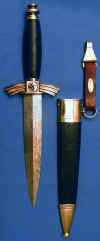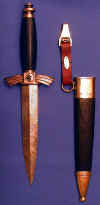|
German Air Sports Formation [Deutscher Luftsport-Verband (DLV)] The German Air Sports Formation incorporated all German civilian aero clubs in March 1933, under the aegis of its newly appointed head, Bruno Loerzer. Its original role was to attract "air minded" Germans into the NSDAP and to emphasise the importance of modern aviation. Three principle groups made up the initial DLV organisation: Flyers of motor-driven aircraft Flyers of gliders Flyers of balloons It acted as a training organisation for the Luftwaffe and swallowed up all air clubs and airfields across Germany. When the Luftwaffe was officially inaugurated as part of the Wehrmacht in 1935 its function was fulfilled, the DLV was dissolved in July 1936. The role of the DLV was partially resurrected in 1937 when the NSFK came into being as the "state flying club" and took over some of the civilian functions of the DLV (training in flying, maintenance etc of powered air vehicles) |
|||
Dagger Information – DLV 1934 Dagger (Fliegermesser - Flyers knife)
The Fliegermesser was introduced at the same time as the DLV Fliegerdolch, for non-officer ranks. It was much smaller than the Fliers dagger being only 34 cm in length. The wooden grip and scabbard where covered in dark blue leather with all fittings in nickel silver with silver plating on early examples. Later examples can be found with a blue painted grip and aluminium fittings and blue painted scabbard. The cross guard was a symbolic set of downward sloping wings with a black enamel swastika at its centre. The knife was suspended from a single Black or brown leather strap, which was permanently attached to the carrying ring of the upper cross guard fitting. Later hanger straps were made from a pressed paper product that looked like leather this is only found on the pained aluminium style. The throat of the scabbard was usually stamped with the DLV emblem (winged swastika & propeller) which indicated that it had passed the DLV inspection and could be issued to wear. No Portapee was worn with the knife. DLV Knife – 1936 Variations From 1936 the DLV knife had a number of changes to its production: 1)… Cheaper aluminium fittings replaced the nickel silver ones 2)… Blue enamel paint replaced the dark blue leather on the grip and scabbard The DLV knifes were recalled upon its dissolution in July 1936. Edited by Bruce Petrin
|



